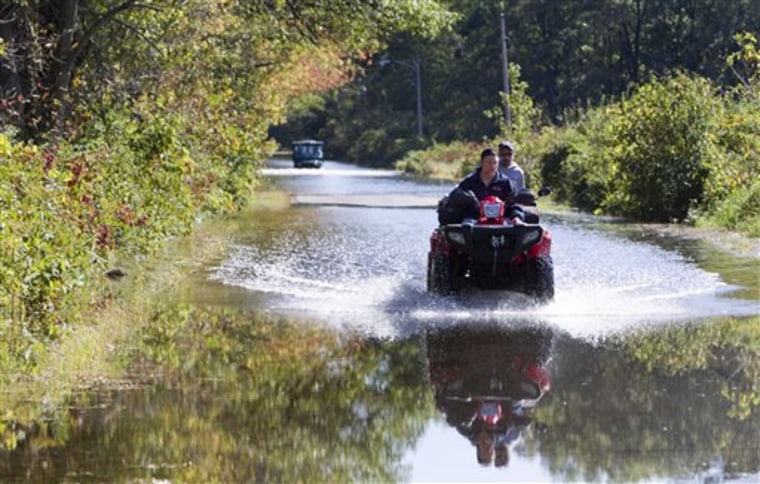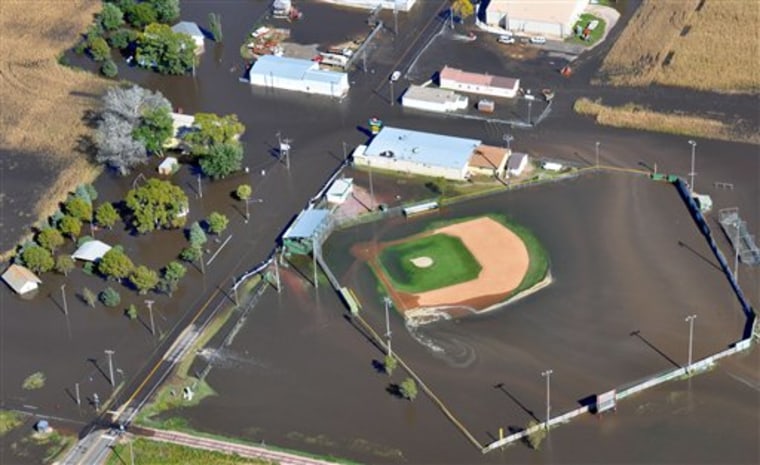Residents in three states on Monday were dealing with flooding that swamped homes and in one area weakened a levee system to near collapse.
In South Dakota, water levels in the storm-bloated Big Sioux River were stable Monday after up to 4 inches of rain last week pushed the waterway over its banks along a 50-mile stretch from Brookings to Sioux Falls.
About two dozen homes in Renner, the worst-hit town, were affected by the rare autumnal flood.
Mike Gillispie, a hydrologist with the National Weather Service, said water levels across Minnehaha County would stay level then start to drop in 24 hours.
Separately, Minnesota Gov. Tim Pawlenty said Monday he plans to call legislators to a special one-day session next month to approve relief money for people affected by floods in that state.
Heavy rain last week caused serious flooding in parts of southern Minnesota. The small towns of Zumbro Falls and Hammond were among the hardest hit.
In Zumbro Falls, floodwaters destroyed 58 homes and 20 businesses, NBC station KARE reported.
In Wisconsin, flood waters from the burgeoning Wisconsin River turned a rural neighborhood into a virtual island Monday, cutting off dozens of homes from the outside world.
The river was seeping through and surging around a levee protecting the Blackhawk Park neighborhood in the town of Caledonia just southeast of Portage. The only road in was covered by nearly a foot of rust-colored water.
A few homes in the neighborhood's low-lying areas were surrounded by water, but most of the houses stood on high ground and remained untouched Monday afternoon.

Emergency workers asked people to leave on Sunday as the river began to rise after last week's heavy rains overwhelmed rivers. Some 300 people live in the neighborhood, and Columbia County Emergency Management director Pat Beghin said about 25 homes remained occupied.
Beghin said the worst-case scenario was water could wash away the access road, stranding those residents for up to a week.
A century-old earthen dike, part of a 14-mile berm, separates Portage and the neighborhood from the river. But the river rose so high and so forcefully it surged around the dike and poured into the bottom lands around the neighborhood, said Steve Miller, director of the state Department of Natural Resources Bureau of Facilities and Lands.
The rising water chipped away at portions of the berm system Monday afternoon. Much of the levee protects forest and farmland, but a breach in the Blackhawk Park portion could make matters far worse for the neighborhood by potentially washing away the access road.
'Not breached' The levee is part of the Caledonia-Lewiston Levee System — several dikes built mainly out of sand during the 1890s by homeowners living near the river, according to the Wisconsin Department of Natural Resources.
"The levee has not breached," a spokesman for the department told msnbc.com. "It is in bad shape but is has not breached."
DNR spokesman Greg Matthews said water is bubbling out of some portions of the levee. Emergency workers have sandbagged those areas, but some saturated portions of the levy system could collapse, Matthews said.
"The entire levee continues to degrade," he said, adding that DNR workers are repairing what they can.
The river overflowed its banks into low-lying areas of Portage, a city of about 10,000 some 40 miles north of Madison. Some residents ventured to the water's edge to watch the river race by.
'I've never seen it move so fast'
Staring at the churning water, Shawn Schweitzer, 39, of Portage, said that usually at this time of the year the water is so low you can nearly drive across the river bottom.
"Now it would be bye, bye," referring to the floating debris. "I've never seen it move this fast," Schweitzer said.
Down the street, Linda Levaggi, 47, a Walmart employee, sat on a bench near the river drawing the swift water on her sketch pad. Levaggi said she wasn't worried about her home because she lives on high ground, but that has never seen the river so high.
"It is a concern," she said.
In Blackhawk Park, Kevin and Lindsay Remus chose to bundle their 17-month-old daughter, Amanda, and leave Sunday.
Kevin Remus told the Portage Daily Register they decided to leave because the road could soon become impassible. The family went to the American Red Cross reception center at St. John the Baptist Episcopal Church in Portage.
Beghin says authorities are monitoring other towns along the river where minor flooding has occurred.
National Weather Service hydrologist Bryan Hahn says the Wisconsin River reached a record level of 20.59 feet Monday at 6 a.m. That breaks a previous record of 20.50 set back in 1938.
The river was expected to hold steady through Tuesday, Hahn said, then slowly decline over the next seven days. Forecasters expect the weather to remain dry in the area for the rest of the week, although a flood warning remains in effect in Columbia County.
